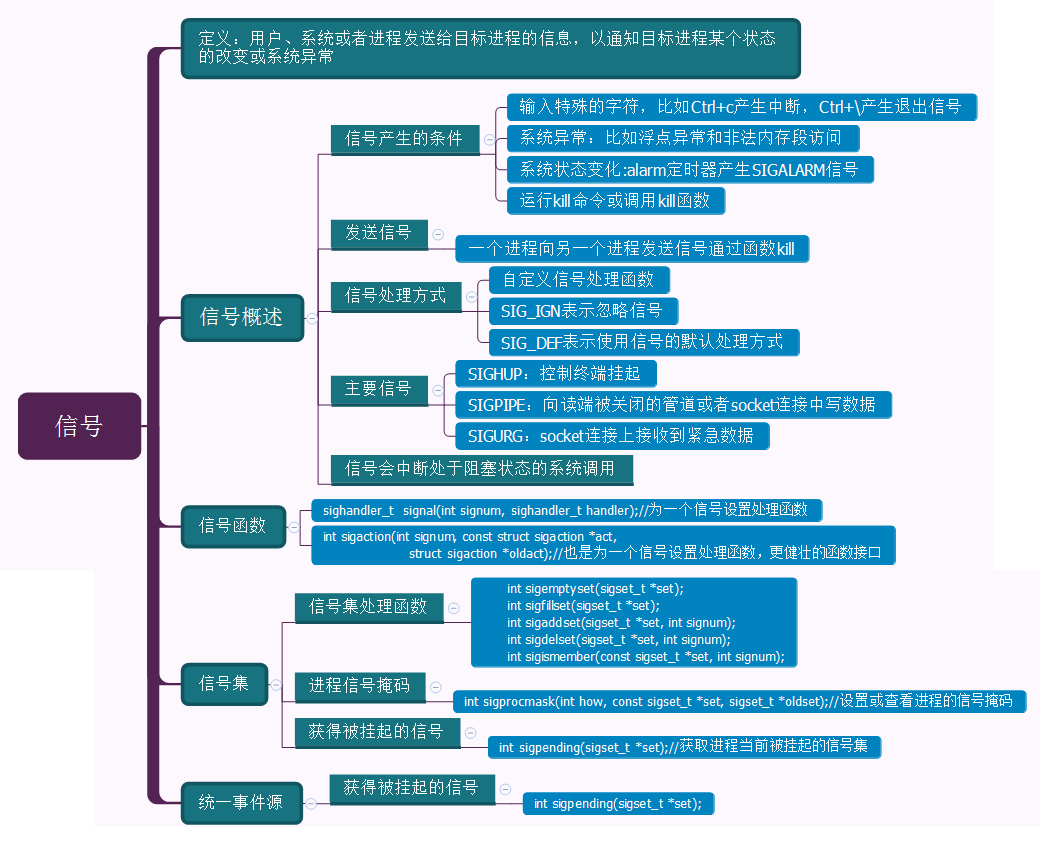linux程式間通訊-----訊號總結
相關文章:
廢話不說,先把所有的訊號列出來(注意裡面沒有32, 33訊號),敲命令 kill -l
還有一個命令 man 7 signal 來檢視訊號的預設行為
後32個訊號表示實時訊號,是可靠訊號,這保證了傳送的多個實時訊號都被接收;
實時訊號都支援排隊,都是可靠訊號;非實時訊號都不支援排隊,都是不可靠訊號;
#include <signal.h>
typedef void (*sighandler_t)(int);
sighandler_t signal(int signum, sighandler_t handler);引數handler還可以指定兩個特殊的值;SIG_IGN是遮蔽該訊號;SIG_DFL是恢復預設行為,SIGINT的預設行為是程式退出;
#include <sys/types.h>
#include <signal.h>
int kill(pid_t pid, int sig);例項1:程式註冊了SIGINT和SIGQUIT訊號的處理函式;
SIGINT的值為2,SIGQUIT的值為3;按下Ctrl+c產生SIGINT訊號,按下Ctrl+\產生SIGQUIT訊號;
/*************************************************************************
> File Name: int_quit_signal.cpp
> Author:
> Mail:
> Created Time: 2015年12月16日 星期三 21時48分22秒
************************************************************************/
#include <iostream>
#include <signal.h>
#include <cstdlib>
#include <unistd.h>
using namespace std;
void handler(int num)
{
cout << "\nrecvive the signal is " << num << endl;
if(num == SIGQUIT){
cout << "recevie the exit signal..." << endl;
exit(0);
}
}
int main(int argc, char *argv[])
{
//註冊中斷訊號SIGINT
signal(SIGINT, handler);
signal(SIGQUIT, handler);
cout << "main process is waiting for the signal of SIGINT and SIGQUIT..." << endl;
while(1){
pause();
}
cout << "main process exit.." << endl;
exit(0);
}

例項2:程式執行的前10秒是遮蔽了SIGINT訊號,所以當產生SIGINT訊號的時候程式不處理直接忽略;10秒過後就恢復預設行為,當產生SIGINT訊號的時候程式直接退出;
/*************************************************************************
> File Name: int_quit_signal.cpp
> Author:
> Mail:
> Created Time: 2015年12月16日 星期三 21時48分22秒
************************************************************************/
#include <iostream>
#include <signal.h>
#include <cstdlib>
#include <unistd.h>
using namespace std;
int main(int argc, char *argv[])
{
//註冊中斷訊號SIGINT
signal(SIGINT, SIG_IGN);
cout << "main process is sleeping(10s)...." << endl;
sleep(10);
cout << "\nthe signal has the default action and waiting the SIGITN to quit..." << endl;
signal(SIGINT, SIG_DFL);
sleep(100);
cout << "main process exit.." << endl;
exit(0);
}

例項3:在這個例子中要使用kill來傳送訊號;程式的內容是,在父程式中註冊SIGINT訊號的訊號處理函式,在子程式中每個2秒鐘就向父程式傳送一個SIGINT訊號;
關於子程式中的每2秒傳送一個訊號,可以簡單的使用while迴圈加上slepp(2)來實現;我這裡使用alarm函式來實現,
該函式設定一個鬧鐘延遲傳送訊號告訴linux核心n秒中以後,傳送SIGALRM訊號;所以我在子程式安裝對SIGALRM的訊號處理函式,並在該訊號處理函式中再呼叫alarm函式;
/*************************************************************************
> File Name: int_quit_signal.cpp
> Author:
> Mail:
> Created Time: 2015年12月16日 星期三 21時48分22秒
************************************************************************/
#include <iostream>
#include <signal.h>
#include <cstdlib>
#include <unistd.h>
using namespace std;
void handler(int num)
{
cout << "parent recvive the signal is " << num << endl;
if(num == SIGQUIT){
cout << "parent receive the signal of quit.." << endl;
exit(0);
}
}
void child_handler(int num)
{
cout << "child receive the signal is " << num << endl;
if(num == SIGQUIT){
cout << "child receive the signal of quit.." << endl;
exit(0);
}
kill(getppid(), SIGINT);//向父程式傳送訊號
alarm(2);
}
int main(int argc, char *argv[])
{
//註冊中斷訊號SIGINT
signal(SIGINT, handler);
signal(SIGQUIT, handler);
pid_t pid = fork();
if(pid < 0){
cout << "fork error..." << endl;
exit(-1);
}
if(pid == 0){
signal(SIGALRM, child_handler);
signal(SIGQUIT, child_handler);
alarm(2);
cout << "this is child process..." << endl;
while(1){
pause();
}
exit(0);
}
cout << "main process is waiting for the signal of SIGINT and SIGQUIT..." << endl;
while(1){
pause();
}
cout << "main process exit.." << endl;
exit(0);
}

值得注意的是,最後從鍵盤傳送了一個SIGQUIT訊號,但是兩個程式(父子程式)都收到了該訊號;如果沒有在子程式中安裝該訊號,那麼父程式會連續收到兩個SIGQUIT訊號;
相關文章
- Linux程式間通訊——使用訊號量Linux
- linux程式間通訊-----管道總結例項Linux
- Linux 程式間通訊之System V 訊號量Linux
- Linux 下的程式間通訊:套接字和訊號Linux
- linux程式間通訊-----System V訊息佇列總結例項Linux佇列
- 程序間的通訊(訊號通訊)
- linux程式間通訊(IPC)小結Linux
- Linux程式間通訊Linux
- 程式間通訊——LINUXLinux
- 程式間通訊——POSIX 有名訊號量與無名訊號量
- “Linux程式設計”小結(程式間通訊)Linux程式設計
- 程序間通訊(4)-訊號量
- Linux程式間通訊-eventfdLinux
- Linux程式間通訊1Linux
- Linux程式間通訊2Linux
- 什麼是程式間通訊?Linux程式間通訊有幾種方式?Linux
- 程式間通訊是什麼?Linux程式間通訊有幾種方式?Linux
- Android中活動間通訊總結Android
- linux 程式間通訊之FIFOLinux
- Linux 的程式間通訊:管道Linux
- linux 程式間通訊之管道Linux
- Linux程式之間如何通訊?Linux
- 程式間通訊
- linux程式和執行緒之間通訊方法和同步方法總結Linux執行緒
- Windows 多程式通訊API總結WindowsAPI
- 程式間通訊機制(管道、訊號、共享記憶體/訊號量/訊息佇列)、執行緒間通訊機制(互斥鎖、條件變數、posix匿名訊號量)記憶體佇列執行緒變數
- linux程式間通訊--管道(PIPE & FIFO)Linux
- Linux程式間通訊②:有名管道FIFOLinux
- linux 程式間通訊之System V 訊息佇列Linux佇列
- 程式間通訊--訊息佇列佇列
- PHP程式間通訊PHP
- 程式間的通訊
- 程式間通訊(Socket)
- 程式間通訊 --IPC
- windows程式間通訊Windows
- 程式通訊之無名訊號量
- 程式通訊方式總結與盤點
- 程序通訊-訊號


